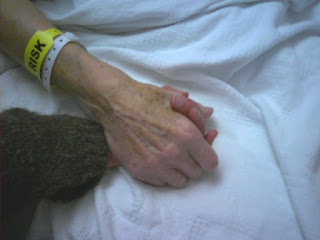 |
| Image Credit: Flickr |
We’ve all been there too many times: A terminally ill patient is rushed to the emergency department (ED) by ambulance in distress, either missing the Physician Orders for Life Sustaining Treatment (POLST) or the family instructs EMS to “do everything.” The ED staff begins to stabilize the patient: inotropes and pressors, central line, intubation, arterial line, pressure bagging, fluids — and then they are told to stop.
Now what? How do you allow the acutely ill patient to pass comfortably with dignity after you just did so many invasive, painful procedures? If there is no other place for the patient but the ED, here are some recommendations, based on literature and my personal experience, to make the patient’s final moments as comfortable as possible.
Preparation [1]
- Put the patient in a private room. The resuscitation bay is not the place to transition a patient to comfort care.
- Get social work, the chaplain, and/or palliative care involved to help with the “small” things that are meaningful (water, chairs for the family, calling family members, etc.) so you can focus on the patient.
- Determine what the most life-threatening physiology is for that patient – it is usually hypotension versus hypoxemia.
Strategy
- 1) If hypotension is the most life-threatening problem, start with some pain and anxiolytic medications while still on hemodynamic support so you can get the effects of the medication started before the patient feels symptoms of hypotension. You can use pushes with or without a drip. Commonly an opiate (e.g., dilaudid, morphine, or fentanyl) is combined with a benzodiazepine (midazolam or lorazepem). [2]
- Wean the inotropes (e.g., epinephrine) and pressors (e.g., phenylephrine) that the patient may already be on over the course of 5-10 minutes or as slowly as needed in order keep up with giving medications to control any symptoms.
- If hypoxemia is the most life-threatening problem, consider doing a terminal wean, rather than a terminal extubation. That is to say, leave the endotracheal tube in place and wean the oxygen (i.e. decrease the FiO2) over the course of 5-10 minutes, titrating your medications as needed, rather than pulling the tube and putting the patient in sudden respiratory distress. [3] Again, give both an opiate and an anxiolytic before making any ventilator changes.
- Which pain and sedative agents, how much, and over what time-course are very patient- and provider-specific decisions. Anecdotally, many clinicians will start an infusion of both pain (e.g., fentanyl 50-100mcg/hr) and sedative (e.g., midazolam 1-2mg/hr) agents once the decision is made for comfort care and other preparations begin. Then give boluses, such as 1-2mg of midazolam for agitation and 50-100mcg of fentanyl for air hunger, as needed, every 2-5 minutes.
Symptom Control
- 1) Don’t be afraid to give relatively, but reasonably, high doses of opiates and benzodiazepines. Use your clinical judgment: an unresponsive 40kg frail female will not need 4 mg of dilaudid, but a 150 kg male on 40mg of methadone a day for cancer pain will need a lot more than 4mg of dilaudid. [4]
- The potential to expedite the patient’s death as a result of trying to provide comfort is an example of the philosophical concept of “double effect.” You have legal and ethical support for providing generous but appropriate comfort so long as your intent was only to provide comfort. [5-7]
- No evidence for this — just experience: ask the nurse to pull extra vials of opiates and benzodiazepines to the bedside before you start weaning the vent or pressors (they can always be returned later). There is nothing worse than your patient being in extremis while the nurse has to run out of the room to grab and prepare more medications. Seconds feel like hours. Be prepared. Be generous.
Final Word
If things aren’t going well or you are uncomfortable and palliative care is not available, call the intensive care unit (ICU). Perhaps some of my intensivist colleagues will disagree, but I firmly believe that part of our job is helping patients die peacefully when we can’t save their lives. At the very least, we may be able to provide recommendations over the phone. Treat the patient like you would treat your own family and you’ll be doing well by your patient.
Recommended Reading
If you’re looking for one, short paper to read, the “Withdrawal of life support: intensive caring at the end of life”, by Predergast, TJ and Puntillo, KA in JAMA is an excellent read.
References
1. Papadimos T, Tripathi R, Rosenberg A, Maldonado Y, Kothari D. An overview of end-of-life issues in the intensive care unit. Int J Crit Illn Inj Sci. 2011;1(2):138.
2. Rubenfeld GD. Principles and practice of withdrawing life-sustaining treatments. Crit Care Clin. 2004 Jul;20(3):435–51–ix.
3. Prendergast TJ, Puntillo KA. Withdrawal of life support: intensive caring at the end of life. JAMA. 2002 Dec 4;288(21):2732–40.
4. Hawryluck LA, Harvey WRC, Lemieux-Charles L, Singer PA. Consensus guidelines on analgesia and sedation in dying intensive care unit patients. BMC Med Ethics. 2002 Aug 12;3(1):E3.
5. Paris JJ, Muir JC, Reardon FE. Ethical and legal issues in intensive care. Journal of Intensive Care Medicine. 1997 Nov;12(6):298–309.
6. McGowan CM. Legal aspects of end-of-life care. Critical care nurse. American Association of Critical Care Nurses; 2011 Oct;31(5):64–9.
7. Truog RD, Campbell ML, Curtis JR, Haas CE, Luce JM, Rubenfeld GD, et al. Recommendations for end-of-life care in the intensive care unit: a consensus statement by the American College [corrected] of Critical Care Medicine. 2008. pp. 953–63.
